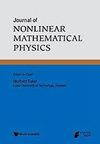Large Time Behavior and Stability for Two-Dimensional Magneto-Micropolar Equations with Partial Dissipation
IF 1.6
4区 物理与天体物理
Q2 MATHEMATICS, APPLIED
引用次数: 0
Abstract
Abstract This paper is devoted to the stability and decay estimates of solutions to the two-dimensional magneto-micropolar fluid equations with partial dissipation. Firstly, focus on the 2D magneto-micropolar equation with only velocity dissipation and partial magnetic diffusion, we obtain the global existence of solutions with small initial in $$H^s({\mathbb {R}}^2)$$具有部分耗散的二维磁微极方程的大时间行为和稳定性
摘要本文研究具有部分耗散的二维磁微极流体方程解的稳定性和衰减估计。首先,对只考虑速度耗散和部分磁扩散的二维磁微极方程,得到了在$$H^s({\mathbb {R}}^2)$$ H s (R 2) $$(s>1)$$ (s &gt;1),充分利用系统的特殊结构,利用傅里叶分裂方法,建立了解的大时间衰减率。其次,当磁场存在部分耗散时,我们在$$\dot{B}^0_{2,1}({\mathbb {R}}^2)$$ B˙2,10 (r2)中证明了具有小初始数据的解的整体存在性。此外,我们还探讨了当初始数据属于负Sobolev空间$$\dot{H}^{-l}({\mathbb {R}}^2)$$ H˙l (r2)时,这些全局解的衰减率对应地建立在$$\dot{B}^m_{2,1}({\mathbb {R}}^2)$$ B˙2,1 m (r2)中,$$0 \le m \le s$$ 0≤m≤s(对于每个$$0 \le l <1$$ 0≤l &lt;1)。
本文章由计算机程序翻译,如有差异,请以英文原文为准。
求助全文
约1分钟内获得全文
求助全文
来源期刊

Journal of Nonlinear Mathematical Physics
PHYSICS, MATHEMATICAL-PHYSICS, MATHEMATICAL
CiteScore
1.60
自引率
0.00%
发文量
67
审稿时长
3 months
期刊介绍:
Journal of Nonlinear Mathematical Physics (JNMP) publishes research papers on fundamental mathematical and computational methods in mathematical physics in the form of Letters, Articles, and Review Articles.
Journal of Nonlinear Mathematical Physics is a mathematical journal devoted to the publication of research papers concerned with the description, solution, and applications of nonlinear problems in physics and mathematics.
The main subjects are:
-Nonlinear Equations of Mathematical Physics-
Quantum Algebras and Integrability-
Discrete Integrable Systems and Discrete Geometry-
Applications of Lie Group Theory and Lie Algebras-
Non-Commutative Geometry-
Super Geometry and Super Integrable System-
Integrability and Nonintegrability, Painleve Analysis-
Inverse Scattering Method-
Geometry of Soliton Equations and Applications of Twistor Theory-
Classical and Quantum Many Body Problems-
Deformation and Geometric Quantization-
Instanton, Monopoles and Gauge Theory-
Differential Geometry and Mathematical Physics
 求助内容:
求助内容: 应助结果提醒方式:
应助结果提醒方式:


